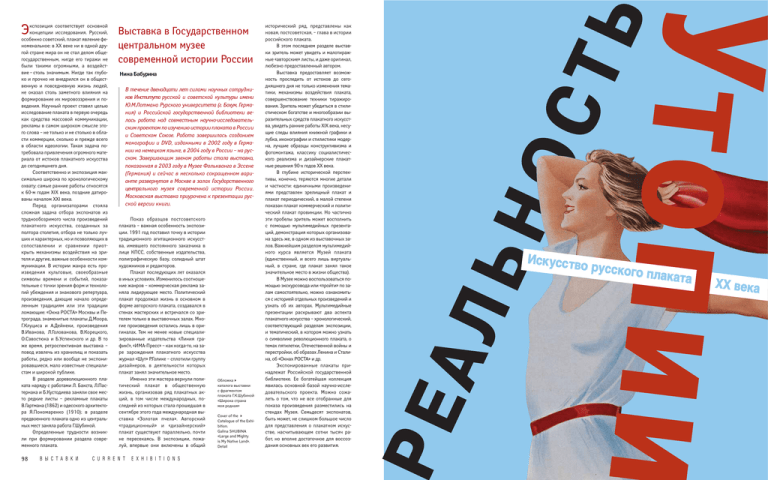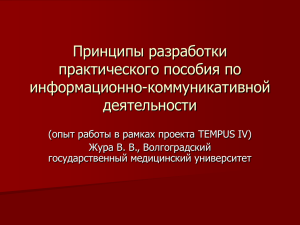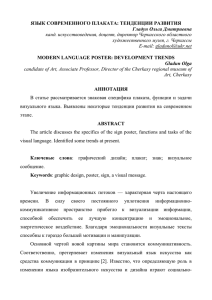XX века Искусство русского плаката
реклама

кспозиция соответствует основной концепции исследования. Русский, особенно советский, плакат явление феноменальное: в ХХ веке ни в одной другой стране мира он не стал делом общегосударственным, нигде его тиражи не были такими огромными, а воздействие – столь значимым. Нигде так глубоко и прочно не внедрился он в общественную и повседневную жизнь людей, не оказал столь заметного влияния на формирование их мировоззрения и поведения. Научный проект ставил целью исследование плаката в первую очередь как средства массовой коммуникации, рекламы в самом широком смысле этого слова – не только и не столько в области коммерции, сколько и прежде всего в области идеологии. Такая задача потребовала привлечения огромного материала от истоков плакатного искусства до сегодняшнего дня. Соответственно и экспозиция максимально широка по хронологическому охвату: самые ранние работы относятся к 60-м годам XIX века, поздние датированы началом XXI века. Перед организаторами стояла сложная задача отбора экспонатов из труднообозримого числа произведений плакатного искусства, созданных за полтора столетия, отбора не только лучших и характерных, но и позволяющих в сопоставлении и сравнении приоткрыть механизмы воздействия на зрителя и другие, важные особенности коммуникации. В истории жанра есть произведения культовые, своеобразные символы времени и событий, показательные с точки зрения форм и технологий убеждения и знакового репертуара, произведения, дающие начало определенным традициям или эти традиции ломающие: «Окна РОСТА» Москвы и Петрограда, знаменитые плакаты Д.Моора, Г.Клуциса и А.Дейнеки, произведения В.Иванова, Л.Голованова, В.Корецкого, О.Савостюка и Б.Успенского и др. В то же время, ретроспективная выставка – повод извлечь из хранилищ и показать работы, редко или вообще не экспонировавшиеся, мало известные специалистам и широкой публике. В разделе дореволюционного плаката наряду с работами Л. Бакста, Л.Пастернака и Б.Кустодиева заняли свое место редкие листы – рекламные плакаты В.Гартмана (1862) и одесского архитектора Я.Пономаренко (1910); в разделе предвоенного плаката одно из центральных мест заняла работа Г.Шубиной. Определенные трудности возникли при формировании раздела современного плаката. Э 98 В Ы С Т А В К И Выставка в Государственном центральном музее современной истории России Нина Бабурина В течение двенадцати лет силами научных сотрудников Института русской и советской культуры имени Ю.М.Лотмана Рурского университета (г. Бохум, Германия) и Российской государственной библиотеки велась работа над совместным научно-исследовательским проектом по изучению истории плаката в России и Советском Союзе. Работа завершилась созданием монографии и DVD, изданными в 2002 году в Германии на немецком языке, в 2004 году в России – на русском. Завершающим звеном работы стала выставка, показанная в 2003 году в Музее Фолькванга в Эссене (Германия) и сейчас в несколько сокращенном варианте развернутая в Москве в залах Государственного центрального музея современной истории России. Московская выставка приурочена к презентации русской версии книги. Показ образцов постсоветского плаката – важная особенность экспозиции. 1991 год поставил точку в истории традиционного агитационного искусства, имевшего постоянного заказчика в лице КПСС, собственные издательства, полиграфическую базу, солидный штат художников и редакторов. Плакат последующих лет оказался в иных условиях. Изменилось соотношение жанров – коммерческая реклама заняла лидирующее место. Политический плакат продолжал жизнь в основном в форме авторского плаката, создавался в стенах мастерских и встречался со зрителем только в выставочных залах. Многие произведения остались лишь в оригиналах. Тем не менее новые специализированные издательства «Линия график!», «ИМА-Пресс» – как когда-то, на заре зарождения плакатного искусства журнал «Шут» Р.Голике – сплотили группу дизайнеров, в деятельности которых плакат занял значительное место. Именно эти мастера вернули политический плакат в общественную жизнь, организовав ряд плакатных акций, в том числе международных, последней из которых стала прошедшая в сентябре этого года международная выставка «Золотая пчела». Авторский «традиционный» и «дизайнерский» плакат существуют параллельно, почти не пересекаясь. В экспозиции, пожалуй, впервые они включены в общий C U R R E N T E X H I B I T I O N S Обложка каталога выставки с фрагментом плаката Г.К.Шубиной «Широка страна моя родная» Cover of the Catalogue of the Exhibition. Galina SHUBINA «Large and Mighty is My Native Land». Detail исторический ряд, представлены как новая, постсоветская, – глава в истории российского плаката. В этом последнем разделе выставки зритель может увидеть и малотиражные «авторские» листы, и даже оригинал, любезно предоставленный автором. Выставка предоставляет возможность проследить от истоков до сегодняшнего дня не только изменения тематики, механизмы воздействия плаката, совершенствование техники тиражирования. Зритель может убедиться в стилистическом богатстве и многообразии выразительных средств плакатного искусства, увидеть ранние работы XIX века, несущие следы влияния книжной графики и лубка, иконографии и стилистики модерна, лучшие образцы конструктивизма и фотомонтажа, классику социалистического реализма и дизайнерские плакатные решения 90-х годов ХХ века. В глубине исторической перспективы, конечно, теряются многие детали и частности: единичными произведениями представлен зрелищный плакат и плакат периодический, в малой степени показан плакат коммерческий и политический плакат провинции. Но частично эти пробелы зритель может восполнить с помощью мультимедийных презентаций, демонстрация которых организована здесь же, в одном из выставочных залов. Важнейшим разделом мультимедийного курса является Музей плаката (единственный, и всего лишь виртуальный, в стране, где плакат занял такое значительное место в жизни общества). В Музее можно воспользоваться помощью экскурсовода или «пройти» по залам самостоятельно, можно ознакомиться с историей отдельных произведений и узнать об их авторах. Мультимедийные презентации раскрывают два аспекта плакатного искусства – хронологический, соответствующий разделам экспозиции, и тематический, в котором можно узнать о символике революционного плаката, о темах пятилетки, Отечественной войны и перестройки, об образах Ленина и Сталина, об «Окнах РОСТА» и др. Экспонированные плакаты принадлежат Российской государственной библиотеке. Ее богатейшая коллекция явилась основной базой научно-исследовательского проекта. Можно сожалеть о том, что не все отобранные для показа произведения разместились на стендах Музея. Семьдесят экспонатов, быть может, не слишком большое число для представления о плакатном искусстве, насчитывающем сотни тысяч работ, но вполне достаточное для воссоздания основных вех его развития. Иск усс тв о русског о плаката XX века Я.М.ПОНОМАРЕНКО Художественно-промышленная выставка Одесса. 1910 The “Objectivity of Utopia”: THE HISTORY OF THE RUSSIAN POSTER he exhibition of posters emphasizes the key concept behind the whole project: the Russian poster, as well as examples from the Soviet era in particular, is a unique phenomenon. In no other country in the world in the 20th century were posters of such national importance; nowhere else were their print-runs so large, or their effect so massive. Nowhere else did they become so deeprooted in the social and everyday life of the population, influencing so profoundly society's ways of thinking and modes of behaviour. The scientific project was, first and foremost, designed to study the poster as a means of mass communication and promotion in the broadest sense. The posters were meant to promote commerce least of all, but predominantly to promote ideology, in particular the Communist ideology. Such a scientific project naturally involved work with a huge illustrative database covering the period from the dawn of poster art right up to the present day. As a result, the exhibition developed into an across-the-board picture, illustrating the phenomenon from the early posters of the 1860s right up to the most recent examples from the beginning of the 21st century. The researchers and curators of the show were faced with the difficult task of choosing the best, as well as the most eloquent and dramatic, examples from the gigantic number of posters made over the last 150 years. Those selected were also meant to enable the viewer to compare and to understand mechanisms of shaping public opinion, as well as other important features associated with the theory and practice of communication. The history of the poster includes some “cult” show-pieces which became almost symbols of their time, high points of the methods and techniques of “subliminal” propaganda and the last word in brainwashing semiotics. They either started new traditions, or concluded existing ones: such were the “Windows of ROSTa” in revolutionary Moscow and Petrograd, including the famous posters by Dmitry Moor, Gustav Klutsis and Аlexander Deineka, and works by Viktor Ivanov, Leonid Golovanov, Viktor Koretsky, Oleg Savostyuk and Boris Uspensky. At the same time a retrospective exposition is T 100 ТРЕТЬЯКОВСКАЯ ГАЛЕРЕЯ An exhibition in the Central State Museum of Russian Contemporary History Nina Baburina The art of the poster, and its history in Russia and the Soviet Union, has been the subject of a 12-year-long research project undertaken by the Lotman Institute of Russian and Soviet Culture at Ruhr University in Germany and the Russian State Library. Their joint effort culminated in a monograph accompanied by a DVD; the German version was brought out in 2002, while its Russian equivalent appeared in Russia in 2004. Finally, an exhibition was held in the Folkvang Museum (Essen, Germany) in 2003, an abridged version of which, now on display in the State Central Museum of Russian Contemporary History in Moscow, is the crowning touch for the project. The Moscow exhibition is it coincides with the publication of the Russian version of the book. Ю.М.БОНДИ Верю, сотую встретим годовщину Кострома. 1920 THE TRET YAKOV GALLERY #1’ 2005 Yury BONDI I Believe We'll Be Celebrating the Centenary Too. Kostroma. 1920 Ya. PONOMARENKO Art and Industrial Design Exhibition Odessa. 1910 traditionally a chance to retrieve from the archives works that have been rarely, if ever, been shown and thus are almost unfamiliar both to experts and the general public. Thus, the pre-1917 period features, alongside posters by Leo Bakst, Leonid Pasternak and Boris Kustodiev, some rare pieces by V. Gartman (1862) or by the Odessa architect Ya. Ponomarenko (1910). One of the central pieces among the pre-WWI posters is the work of Galina Shubina. Work on curating the display of modern, contemporary posters brought with it certain difficulties. The post-Soviet poster is seen as an important feature in the exhibition, given that the year 1991 was a critical juncture in the history of the traditional propaganda poster; the powerful Communist Party ceased to be the key sponsor and customer for the Soviet Union's vast poster-manufacturing industry with its specialized publishers, printing-houses, and full-time staffs of artists and editors. The poster of this later period existed in somewhat different conditions. The mass advertising poster came to dominate, while the political propaganda placard became an exclusive item to be found only in the authors' studios or at art shows; some were destined to exist in only one, original copy. At the same time, however, some new, dedicated publishing agencies, like “Liniya Grafik!” and “IMAPress”, in a similar fashion to the magazine “Shut” (Fool) initiated by Roman Golike at the very beginning of poster printing in the 19th century, pooled their efforts and encouraged a group of designers specializing in the form to continue their work. Thanks to such enthusiasts the Russian political poster has not disappeared from the contemporary artistic scene. They have initiated a number of international poster shows, such as the “Golden Bee” International Moscow Biennale of Graphic Design in September 2004. Such shows have demonstrated that two trends – the “traditional” and the “auteur” poster – coexist, though rarely overlap. The exhibition in question managed to arrange them, perhaps for the first time ever, in the same historic tier, presenting the two trends as the new, post-Soviet, Russian Д.С.МООР Помоги Москва. 1922 Dmitry MOOR Help! Moscow. 1922 Г.К.ШУБИНА Широка страна моя родная Москва. 1938 Galina SHUBINA “Large and Mighty Is My Native Land” Moscow. 1938 О.М.САВОСТЮК, Б.А.УСПЕНСКИЙ Мы думали, люди, о вас... Агитплакат № 2095 Москва, 1967 Oleg SAVOSTYUK, Boris USPENSKY “We Thought Of You, People…” Agitprop placard no. 2095 Moscow, 1967 В.Б.ЧАЙКА Памяти жертв Чернобыльской АЭС… 1986–1996 Москва. 1996 Vladimir CHAIKA “Long Memory to the Victims of the Chernobyl Tragedy…” 1986–1996 Moscow. 1996 poster. The closing section of the show offers the viewer some limited-circulation prints, and even one original kindly offered by its author especially for the exhibition. The display does not only follow, step by step, the development of the poster, covering transformations of subject and mechanisms of impact on the viewer, or the improved quality of printing. It also gives plentiful proof of the prolific stylistic and expressive nature of the form: from early pieces from the 19th century influenced by book illustrations and the “lubok” popular print, to those bearing signs of iconography and “art deco”, or fine examples of Constructivism and photo-montage, as well as “Socialist Realism” classics and the “auteur” works of the 1990s. Historic perspective often evens up details. Thus, entertainment or regularly-repeated posters are illustrated by only one or two pieces; commercial posters or provincial political ones undoubtedly deserved more attention. Such a deficiency is partially compensated for by the multimedia demonstrations arranged in one of the exhibition halls. The most prominent feature of those demonstrations is the Museum of the Poster, the only one of its kind, existing solely online – strange though that may sound in the country where posters have played such a significant role in public life! The Museum offers viewers a guided tour, as well as the opportunity to browse the Museum's files, complete with associated stories about the works and their creators. The multimedia demonstrations provide a double view of poster art: a chronological one that follows the major works in the exhibition, and a topical one that investigates the symbolism of the 1917 revolutionary posters, the most common subjects of the five-yeareconomic-development-plans, or those of the Great Patriotic War and perestroika, the images of Lenin and Stalin in posters, the subjects and authors of “Windows of ROSTa” and others. The rich collection from which the exhibition was drawn, which became the base for accompanying scientific research, belongs to the Russian State Library. It can only be regretted that the Museum could afford to frame only seventy from the hundreds of thousands of pieces that make up its collection. Nevertheless, even such a display can be seen as an achievement in reconstruct-ion of the history of the poster itself. В Ы С ТА В К И CURRENT EXHIBITIONS 101

